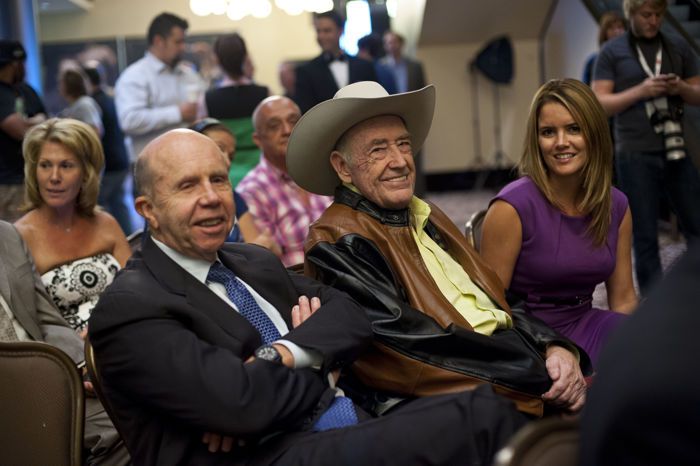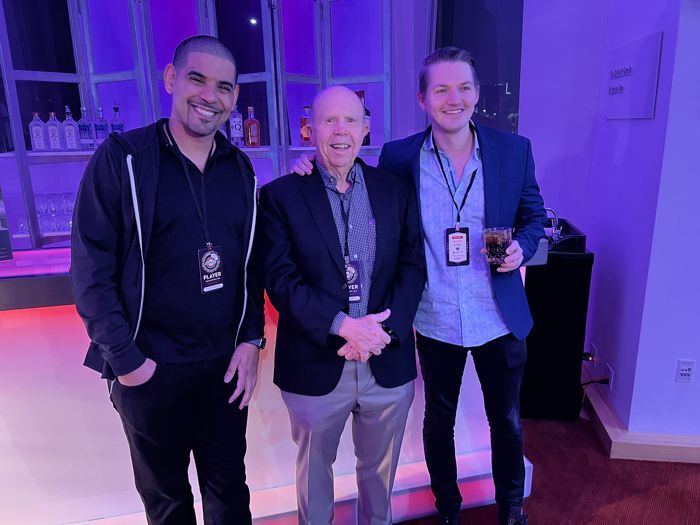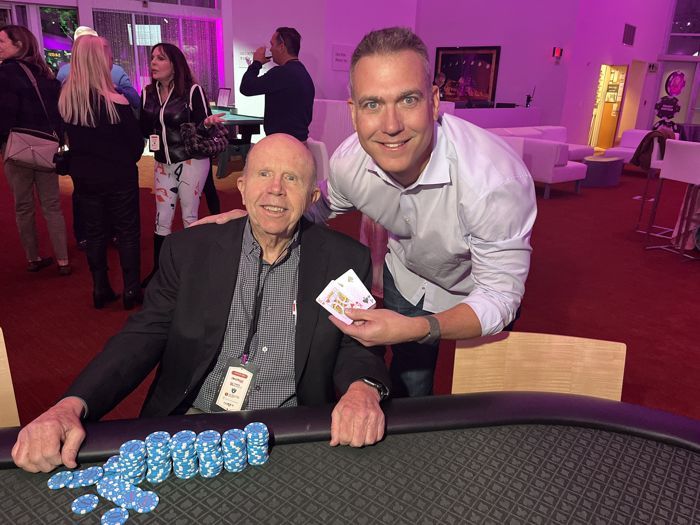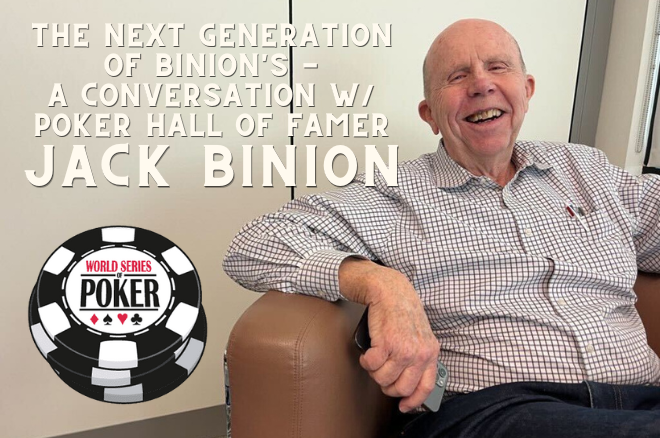This summer, hundreds of thousands of players will pass through the doors of the newly-renovated Horseshoe Las Vegas, formerly known as Bally’s. For the second year in a row, the venue will play host to the annual World Series of Poker (WSOP).
As players pack the casino for the 54th annual WSOP, many of them will saunter by a lavish steakhouse. For some, it’ll be just another restaurant, maybe one they’ll attend to celebrate a bracelet win, but for others, they’ll recognize the name on the sign, the man responsible for poker’s premier event – Jack Binion.
Now 86 years old, Binion is a titan of the gaming industry and the son of casino magnate Benny Binion. Together, they launched the WSOP back in 1970 at Binion’s Horseshoe in downtown Las Vegas. Over the next four decades, Jack Binion would go on to change not only the poker landscape but also the casino industry throughout the United States. Along the way, he was inducted into the Poker Hall of Fame and became an icon of the game.
Binion doesn’t relish the spotlight, so interviews with the born-and-raised Texan are few and far between. However, late last year he sat down with PokerNews for an intimate and in-depth conversation about his life in poker.
Here’s the Full Schedule for 2023 World Series of Poker (WSOP); Win Main Event for Life!
Making Their Way to Vegas
In the early part of his life, Benny Binion ran illegal gambling operations in Dallas, Texas. The exploits of the gambling icon have been immortalized in books such as I’ll Do My Own Damn Killin’ by Gary Sleeper and Blood Aces: The Wild Ride of Benny Binion, the Texas Gangster Who Created Vegas Poker by Doug J. Swanson and is a tale too long to tell here. However, his son, Jack, remembered those early days.
“My family left Texas in 1947. Actually, my dad came out early,” Binion told PokerNews. “Let’s face it, there were many illegal gambling casinos in America at this time, and it was right after the war. People can now travel again, and I don’t know if you remember what the Kefauver Committee was, but there was a movement throughout the country to close illegal gambling there. In the Fall of 1946, a reformed administration came into Dallas and they shut the town down. When I say they shut the town down, it was always illegal but it was tolerated. All right. Well, after this, we would not be tolerated, and that’s when we moved to Vegas. I came out here in 1947 at a semester break.”
Despite his father’s business, which often involved run-ins with the law and incidences fraught with violence, Jack remembers his time in Texas as a happy time.
“I always had a great childhood,” he said. “Yeah, my father and my mother, I can’t think of two people that were more devoted to your children than my parents were. My dad was very permissive in a way. But anyway, so, yeah, I had a great childhood and he opened [the Horseshoe] in 1951. Before that we would always go to a ranch he owned in Montana and all summer we’d spend all our time at the ranch.”

The Binion family bounced back and forth between Vegas and the Montana Ranch, but eventually, the patriarch’s past came knocking.
“[My dad] opened the Horseshoe and he was very successful with it, and then, unfortunately, they indicted him for income tax evasion and Gambling Row back in Texas. They finally got him back there and they put him in jail and he had to sell the Horseshoe. Right. And he sold it to Joe W. Brown, who is a gambler from New Orleans that had a play for many years in Saint Bernard Parish, which is just actually a suburb of New Orleans.”
Binion continued: “Actually, he didn’t know Joe Brown that well, but Joe Brown was a good guy, and his reputation was well-deserved. He was very rich. Yeah. What had happened – he was a very successful gambler but then he invested in oil, and he hit a huge gas field down in Louisiana. After he died, they sold that gas field for $47.5 million, which at this time would be at least $470 million. Probably more, right? Probably double that. In fact, there’s a good chance that if they had the Forbes 400 in those days, Joe Brown would have been on it.”
Eventually, Brown got sick and sold the casino to a group that owned The Fremont. At the time, Jack Binion, who was 27, owned 2.5 percent of the business, but when the group hit money problems and was looking to sell, he managed to work it up to 25 percent.
“Then when we bought it out, we borrowed the money from the bank and a bunch of stuff. We owned 100% of the place,” explained Binion, who would go on to serve as both President and General Manager of the Horseshoe.
WSOP Formation
While Jack Binion was the top dog on the Horseshoe on paper, Benny still pulled the strings behind the scenes. Known for their $1 million display of $10,000 bills and a willingness to take bets of any amount, Binion’s Horseshoe became a popular Vegas destination. That was good news for poker players as Benny Binion had a fondness for them, including long-time friend Johnny Moss.
It was Benny’s connection to the game that would lead to an invitation to Reno in 1969.
“Me and my brother and my father kind of never traveled much together, but the guy from Austin, Texas, that owned a casino in Reno, and he invited us to a thing called a Gamblers Convention,” Jack Binion explained. “Well, my dad said, let’s go up there. So, we did. We all liked it. He loved to travel with me and my brother or one of us, you know? And it was just a poker game. That’s where I met Doyle [Brunson]. The next year we remodeled the Horseshoe and expanded it including a card room.”

The man Binion referred to was Tom Moore, owner of the Holiday Hotel. He opted not to run the reunion the following year, which inspired the Binions to step up to the plate.
As Binion told PokerNews: “So, we said, okay, that’s not a bad idea. I called those guys up and said, ‘You guys going to do that convention again?’ They said no and I said, ‘Well, you know what? And if we do it?’ He said, no [problem]. And that’s how it took off and how it started.”
Thus, the World Series of Poker was born, though that first year in Vegas wasn’t played in a tournament format. Instead, attendees played various cash games and at the end of it all they voted on the best player, which wound up being the aforementioned Johnny Moss.
“They just got six guys together to do it and I named it the World Series of Poker.”
“I’m going to tell you what, okay? It never crossed my mind or anybody else’s, obviously, to have an actual game, a gambling tournament where there was a winner,” said Binion. “So, I just go around and say, you know, who do you think the better player is? So, the guy that got the most second-place votes, he was kind of the king of the gamblers then. Right. And I’ll tell you who really came up with the idea of a freeze out was Amarillo Slim.”
He continued: “In the old days, most of the freezeouts were like two guys would play, and they’d put up ten apiece and just one would win at all. I don’t even think anybody ever had a multiple-person freezeout. The truth was, it was just an afterthought. And they just got six guys together to do it and I named it the World Series of Poker because at the time I thought, well, say in the ‘World of Poker Championship’ is a little bit presumptuous. You know, there are six people … Actually, it didn’t really catch on right away, and we didn’t really get any publicity. None of the gamblers wanted any publicity.”
In those early years, the WSOP Main Event wasn’t the main attraction. The players much preferred cash games, but for the sake of the media, a tournament was held to crown a world champion.
“We just had a poker tournament every year and we’d get the poker tournament because it was good publicity and everything,” Binion admitted. “Yeah. But the rest of the time, we put slots in that area. Slots made a lot more money for sure.”
Poker & Pop Culture: Jack Binion Sorts Fact From Fiction Regarding Moss-Dandolos Match
Remembering Some WSOP Legends

One of the reasons the WSOP caught on was due to a colorful cast of characters, many of who Binion remembers fondly such as the late Puggy Pearson.
“Pug was a good poker player. What interested me in Pug, he said to me that his family moved – I think nine times in 18 months – because his father would never pay the rent. And he had like eight or nine kids. And he says, ‘I was so poor the first time I ever saw sliced bread I thought it was cake.’ … Pug just was self-raised, and self-educated. It’s kind of interesting because Pug, how he approached stuff, and he just his deductive reasoning. He did it not only with gambling but everything.”
Then there was fellow Texas Jack “Treetop “ Strauss.
“Strauss was one of the most unique player. Now the trouble with Strauss, he loved to play so much that he stayed broke all the time and he bet sports. He was the first guy I ever saw that … would be playing and listening on a transistor radio to baseball games and all that kind of stuff. So, he was just go, go, go, go all the time.”
“Strauss was a pretty big bookmaker around Houston, okay, but he was always running low and nobody realized it back then.”
To demonstrate his point, Binion shared a story about Treetop.
“It doesn’t have anything to do really with poker, but it shows how Strauss was. Strauss was a pretty big bookmaker around Houston, okay, but he was always running low and nobody realized it back then. But he was always very thin in the bankroll department. So, his best customer was from Lafayette, Louisiana and the guy called Strauss up and said, ‘Listen, I’ll be over there Tuesday morning to come get the money.’
“So now Strauss doesn’t have the money, but after the Monday Night Football, he could go out and he would be able to, you know, collect it away. By Tuesday night, he would have the money, but he was not going to have the money when the guy showed up. So, he said, ‘Oh, what am I going to do?’ The point of the story was how clever Strauss was. He looks over and there was a friend of his that had gone to work for an insurance company that had kind of a plain Ford sedan, and a guy, you know, dressed in a kind of a plain suit. He called the guy up and he said, ‘Listen, I’ll wait underneath there for the cashier of whatever hotel and I’ll come get you. I’ll bring the money.’ He knew that the guy would be able to see coming up the way.
“So, he’s coming up with a sack, carrying this sack headed for the guy, and about a block and a half away, the car comes up. [His friend] get out and throws him up against the wall. He throws him in the car and they drive off. Later he calls the other guy up and he says, ‘You’re not going to believe what happened.’ The guy said, ‘Don’t say a word. I saw the whole thing.; Strauss said the guy didn’t come to get the money for another two weeks, and it shows how quick Strauss would think.”
Speaking of Strauss, he is well-known for his “chip-and-a-chair” comeback in the 1982 WSOP Main Event where he seemingly went all in only to notice after the hand that he had one chip underneath a napkin. Because he never said “all in,” the chip was live and he made a historic comeback. Binion remembers it well, and he doesn’t think it was an accident.
“He knew what the hell he was doing,” Binion shared. “I think he knew that chip was there. He knew, I think so … But that’s typical Strauss.”
A Poker Family
Because the community was much smaller back then, those who attended the WSOP became like a family with the Binions playing a prominent role. It became apparent that if you were at the WSOP at Binion’s Horseshoe, you were going to see Jack, which is evidenced by the numerous WSOP photos from the 1970s through the 90s.
“I was really working hard. I work seven days a week. One time, I went a year and a half without a day off,” said Binion. “When we first took over the Horseshoe, I wanted to make sure it was a success. But almost more than anything else, fear of failure made me work really hard.”
As for the players, Binion remembered them as a sort of fraternity.
“Number one, everybody came from kind of a same background and they had more in common and they played every day with each other. The camaraderie and interaction with each other now are nowhere near what it was in those days. In those days, every night they had dinner together or you know, they played golf together. So, there was always a lot of interaction.”
He continued: “There was just a lot more interaction with each other, and like I say, a lot more camaraderie. They were all what you might say, maybe not their best friend, but they were all together. It was a click, you know, of all these players, like a family.”

Eventually, newer players began to infiltrate the WSOP and change the game. Binion remembers Phil Hellmuth, now the most decorated player in WSOP history with 16 gold bracelets, as a disruptor.
“Phil was really the first what I call ‘modern players.’ He was a college kid who came out of nowhere … Phil won that tournament [in 1989], and by then, people at first, they didn’t really understand how important strategy was in those poker tournaments. Phil was one of the first ones, I think, to really do that.”
Poker Hall of Famer Jack Binion on 2022 WSOP: “My Hat’s Off to Them
Building an Empire Outside Vegas
The year that Hellmuth won the WSOP was the same year that Benny Binion passed away on Christmas Day. Jack would continue to run the Horseshoe with other family input, but after a decade, during which his mother Teddy Jane passed away in 1994, family politics and drama led to him selling his shares to his sister, Becky Binion-Behnen. As part of the deal, he was able to take the Horseshoe brand on the road.
“I sold out to my sister in 1998 … I said there’s going to be a big opportunity [as gambling expanded across the country] and they wouldn’t do it. So, I said, ‘Well, I’m going to take the kids and I’m going to go.’ Do I want to save the kids, the grandchildren, the grand nieces and nephews? We formed a new company, and that the company that had all the Horseshoes in the Midwest and South.”
For Jack, it proved a wise decision as his casinos, such as Horseshoe Tunica, quickly flourished. Meanwhile, his sister’s woes continued and she eventually sold the Las Vegas casino to Harrah’s, which would later become Caesars Entertainment. Binion’s properties would follow, but what he built lives on as Horseshoe venues can be found in Baltimore, Hammond, Bossier City, Council Bluffs, Tunica, Indianapolis, Lake Charles, St. Louis, Black Hawk, and now, once again, in Las Vegas!

“To this day, this financial office runs all the money for me and all the kids, and now we’re into the next generation,” Binion said with a smile. “There’s 16 people in the next generation, from 13 down to about three weeks old as part of the whole family. So, the whole family is really together right now.”
So, this summer while you’re at the WSOP, maybe stop into Jack Binion’s Steak and raise a glass to the man who helped start it all.
For more, listen to Jack Binion tell his stories on this episode of the PokerNews Podcast:

Executive Editor U.S.
Executive Editor US, PokerNews Podcast co-host & 2013 WSOP Bracelet Winner.
